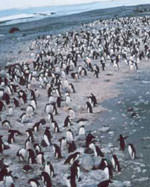
Image credit: NASA
NASA satellite data has been used to analyze the biology of open area “hotspots” around the coast of Antarctica. The research has found that penguin populations are healthy when there are patches of open water nearby where plankton blooms can form in the sunlight. The plankton feeds shrimp-like krill which supports many other marine animals including penguins. The data was gathered by NASA’s Sea-viewing Wide Field-of-view Sensor (SeaWiFS) and NOAA’s Advanced Very High Resolution Radiometer (AVHRR) which kept weekly records of ocean temperature and plankton levels.
NASA satellite data was used for the first time to analyze the biology of hot spots along the coast of Antarctica. The biological oases are open waters, called polynyas, where blooming plankton support the local food chain.
The research found a strong association between the well being of Adelie Penguin populations in the Antarctic and the productivity of plankton in the polynyas. Polynyas are areas of open water or reduced ice cover, where one might expect sea ice. They are usually created by strong winds that blow ice away from the coast leaving open areas, or by gaps appearing on the ocean’s surface, when flowing ice gets blocked by an impediment, like an ice shelf.
The Antarctic waters are rich in nutrients. The lack of ice, combined with shallow coastal waters, provides the top layers of the ocean with added sunlight, so polynyas offer ideal conditions for phytoplankton blooms. Because the ice around polynyas is thin in the early spring when the long Austral day begins, they are the first areas to get strong sunlight. The open waters retain more heat, further thinning ice cover and leading to early, intense, and short-lived plankton blooms. These blooms feed krill, a tiny, shrimp-like animal, which in turn are eaten by Adelie Penguins, seabirds, seals, whales, and other animals.
Although relatively small in area, coastal polynyas play a disproportionately important role in many physical and biological processes in Polar Regions. In eastern Antarctica, more than 90 percent of all Adelie Penguin colonies live next to coastal polynyas. Polynya productivity explains, to a great extent, the increase and decrease in penguin population.
“It’s the first time anyone has ever looked comprehensively at the biology of the polynyas,” said Kevin Arrigo, assistant professor of Geophysics at Stanford University, Stanford, Calif. “No one had any idea how tightly coupled the penguin populations would be to the productivity of these polynyas. Any changes in production within these polynyas are likely to lead to dramatic changes in the populations of penguins and other large organisms,” Arrigo said.
The study, which appeared in a recent issue of the Journal of Geophysical Research, used satellite-based estimates to look at interannual changes in polynya locations and sizes; abundance of microscopic free-floating marine plants called phytoplankton, which are the base of the polar ocean food chain; and the rate at which phytoplankton populations thrive. Covering five annual cycles from 1997 to 2002, 37 coastal polynya systems were studied.
The largest polynya studied was located in the Ross Sea (396,500 square kilometers or 153,100 square miles; almost the size of California). The smallest was located in the West Lazarev Sea (1,040 square kilometers or 401.5 square miles). Most polynyas, at their maximum area in February, were less than 20,000 square kilometers (7,722 square miles).
Data from NASA’s Sea-viewing Wide Field-of-view Sensor (SeaWiFS) and NOAA’s Advanced Very High Resolution Radiometer (AVHRR) provided weekly measurements of chlorophyll and temperature that were used in a computer model to estimate phytoplankton productivity. The researchers found, taken together, the Ross Sea, Ronne Ice Shelf, Prydz Bay, and Amundsen Sea polynyas were responsible for more than 75 percent of total plankton production.
The researchers were surprised to find how closely connected the Adelie Penguins were to the productivity of their local polynyas. The more productive polynyas supported larger penguin populations. The more abundant krill fed more penguins, and the birds had shorter distances to go to forage, which reduced exposure to predators and other dangers.
The NASA Oceanography Program, the National Science Foundation, and the U.S. Department of Energy funded this research. NASA’s Earth Science Enterprise is dedicated to understanding the Earth as an integrated system and applying Earth System Science to improve prediction of climate, weather, and natural hazards using the unique vantage point of space.
Original Source: NASA News Release
